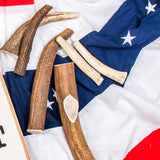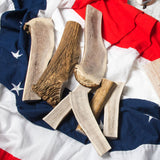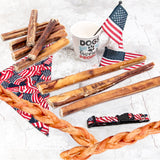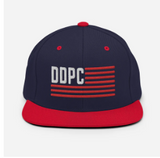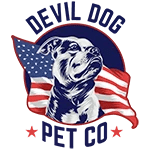The best dental chews for dogs combine mechanical cleaning with proper sizing, appropriate hardness, and VOHC approval—but 90% of products on the market fail at least one of these tests. After watching our dog Dexter destroy "dental" treats in seconds without any cleaning benefit, we've spent five years testing every option worth mentioning. The hard truth? Most dental chews are glorified dog cookies with fancy packaging.
Key Takeaways
- The best dental chews for dogs combine mechanical cleaning with proper sizing, appropriate hardness, and VOHC approval.
- 90% of dental chew products on the market fail at least one important effectiveness test.
- Many dental chews are simply dog treats with little to no actual cleaning benefit.
- Testing over five years revealed that some dental chews do not withstand chewing long enough to provide dental benefits.
Table of Contents
- The Truth About Dog Dental Chews: What Actually Works
- Why Dental Chews Matter for Dogs
- The VOHC Seal: Your First Filter for Dental Chew Quality
- 5 Vet-Approved Dental Chews That Actually Work
- Best Dental Chews for Puppies: Special Considerations
- How to Choose the Right Dental Chew for Your Dog's Needs
- How to Use Dental Chews Effectively: A Marine's Approach to Canine Dental Health
- Red Flags: What to Avoid in Dental Chews
- Real-World Results: What to Expect From Quality Dental Chews
- Best Dental Chews for Specific Needs: Finding the Perfect Match
- Natural vs. Synthetic Dental Chews: The Honest Comparison
- Making Dental Chews Part of Your Leadership Strategy
- Conclusion: Dental Chews as Preventative Investment
I'll cut through the marketing noise and give you the straight facts about what actually works for canine dental health—because preventing periodontal disease means more than fresh breath. It means avoiding painful extractions, dangerous infections, and thousands in vet bills.
When we founded Devil Dog Pet Co., we committed to only recommending dental solutions that deliver real results. Let's dive into what science says about keeping those canine chompers healthy.
Why Dental Chews Matter for Dogs

By age three, 80% of dogs show signs of dental disease. Let that sink in. The majority of our four-legged family members are suffering from preventable mouth pain that silently damages their overall health.
Here's what happens without proper dental care: plaque forms within hours after eating, hardens into tartar within days, and creates the perfect environment for bacteria to thrive. These bacteria don't just cause bad breath—they create inflammation that destroys gum tissue and bone, eventually leading to tooth loss.
Even worse, these same bacteria can enter the bloodstream through inflamed gums and damage vital organs including the heart, liver, and kidneys. That's why veterinary dental specialists consider oral health a cornerstone of overall canine wellness.
How Quality Dental Chews Actually Work
Effective dental chews work through three primary mechanisms:
- Mechanical abrasion: The texture scrapes against teeth, physically removing plaque
- Extended chew time: Longer chewing increases saliva production, which helps neutralize acid and wash away food particles
- Active ingredients: Some chews contain enzymes or other compounds that break down plaque biofilm
The key word here is "effective." Not all chews deliver on these mechanisms, which is why I'm about to save you time and money by separating the winners from the pretenders.
The VOHC Seal: Your First Filter for Dental Chew Quality
The Veterinary Oral Health Council (VOHC) provides the gold standard for dental product effectiveness. Products earning their seal must demonstrate at least a 15% reduction in plaque or tartar in controlled clinical trials.
This isn't marketing fluff—it's peer-reviewed science. When you see that seal, you know the product has been tested and proven effective under standardized conditions. For a complete and current list of VOHC-accepted dental chews, check their official directory.
But here's where it gets tricky: many popular "dental" treats don't carry this certification. Why? Because they can't pass the tests. Instead, they rely on clever packaging and vague claims to separate you from your money while doing little for your dog's teeth.
Beyond the Seal: What Else Matters
VOHC approval is necessary but not sufficient. The best dental chews for dogs must also:
- Match your dog's chewing style (aggressive vs. gentle)
- Be appropriately sized (too small = choking hazard; too large = avoidance)
- Contain quality ingredients (avoid excessive starches and sugars)
- Provide reasonable caloric value (dental health shouldn't cause obesity)
When we first brought these standards to our product testing with Dexter, we were shocked at how many popular brands failed these basic requirements.
5 Vet-Approved Dental Chews That Actually Work
After consulting with veterinary dentists, analyzing clinical research, and testing products with hundreds of customer dogs (plus our own), here are the dental chews that genuinely deliver results:
1. Split Elk Antlers
While not technically marketed as "dental chews," split elk antlers earn their place at the top of our list for several compelling reasons:
- Exceptional abrasive texture that effectively scrapes plaque from teeth
- Extended chew time (often 30+ minutes per session for weeks)
- Zero additives, chemicals, or artificial ingredients
- Naturally shed and sustainably sourced
- Non-digestible, so zero caloric impact
The exposed marrow in split antlers makes them appealing even to picky chewers, while the hard outer surface provides excellent mechanical cleaning. For power chewers, whole antlers offer even greater longevity. For more options, visit our split antler dog chews collection.
Caution: Always supervise and select appropriate sizes to prevent tooth fractures in aggressive chewers.
2. Greenies Original Dental Treats
The first VOHC-approved dental chew remains one of the best:
- Proven 60% reduction in tartar buildup
- Unique texture and shape for cleaning hard-to-reach areas
- High digestibility (94%) for safety
- Available in multiple sizes for proper fit
The distinctive toothbrush shape helps Greenies clean the gumline and back teeth where problems often begin. Their bendable texture works well for moderate chewers but may disappear too quickly with power chewers.
3. Himalayan Yak Cheese Chews
These traditional hard cheese chews have gained popularity for good reason:
- Exceptionally hard texture provides extended chew time
- Simple ingredient list (yak/cow milk, lime juice, salt)
- No artificial preservatives or colors
- High protein, low fat nutritional profile
While not specifically VOHC-approved for dental benefits, the extended chew time and hard texture make these excellent for mechanical plaque removal. As a bonus, the small end pieces can be microwaved into crunchy puffs, eliminating waste. Explore our yak cheese Himalayan dog chews for a healthy option.
4. WHIMZEES Brushzees
These vegetable-based dental chews offer several advantages:
- VOHC-approved for both plaque and tartar control
- Unique shape with grooves and nubs for improved cleaning
- Limited, natural ingredient list
- Grain-free and vegetarian formula
The distinctive shape includes knobs and grooves that help clean between teeth, while the vegetable-based formula makes them suitable for dogs with protein sensitivities. They're harder than Greenies but softer than yak chews, making them a good middle-ground option.
5. Virbac C.E.T. VeggieDent Tartar Control Chews
These plant-based dental chews offer a unique approach:
- VOHC-approved for tartar reduction
- Z-shape design maximizes contact with teeth surfaces
- Contains Zinc to help prevent tartar mineralization
- Vegetable-based formula is highly digestible
These chews work well for dogs with sensitive stomachs who might not tolerate protein-based options. The chewy texture provides good mechanical cleaning without being too hard for moderate chewers. For more science-backed picks, see PetMD's best dental chews for dogs as verified by veterinarians.
Best Dental Chews for Puppies: Special Considerations

Puppies require special attention when it comes to dental chews. Their teeth and jaws are still developing, and their chewing habits can be unpredictable. Here's what works best for the younger crowd:
Puppy-Specific Options That Actually Work
For puppies under 6 months with all their adult teeth:
- Oversized split elk antlers - The exposed marrow is softer while the outer surface provides gentle cleaning (always supervise)
- Puppy Greenies - Specifically formulated to be softer for developing teeth
- Small Himalayan yak chews - Hard enough for cleaning but not rock-solid like the larger versions
The critical factor with puppies is supervision. Their enthusiasm often exceeds their judgment, and what begins as proper chewing can quickly become gulping or aggressive biting.
When we first introduced Dexter to dental chews as a puppy, we limited sessions to 10-15 minutes and always stayed within arm's reach. This allowed us to monitor his chewing style and intervene if he tried to swallow pieces that were too large.
How to Choose the Right Dental Chew for Your Dog's Needs
Finding the perfect dental chew isn't just about grabbing whatever's on sale at the pet store. It requires matching the product to your dog's specific chewing style, size, and dental needs. After watching countless dogs (including our dog Dexter) interact with different chews, I've developed a foolproof selection system.
Step 1: Assess Your Dog's Chewing Style
Dogs generally fall into three chewing categories:
- Inhaler: Barely chews before swallowing (needs supervision and durable options)
- Methodical: Takes time to work through treats (ideal for most dental chews)
- Shredder: Tears items apart aggressively (requires extremely durable options)
Be honest about your dog's style. When we first assessed Dexter, we wanted to believe he was methodical, but his shredding tendencies meant softer dental chews disappeared in seconds with minimal dental benefit.
Step 2: Match Hardness to Jaw Strength
This critical step prevents both ineffective cleaning and potential tooth damage:
- Puppies/Seniors: Softer options like Puppy Greenies or split antlers
- Average Adult Dogs: Medium-hardness options like standard Greenies or WHIMZEES
- Power Chewers: Extremely durable options like whole antlers or extra-large yak chews
The best dental chews for dogs strike that perfect balance—hard enough to clean effectively but not so hard they risk fracturing teeth. When in doubt, consult your veterinarian about your dog's specific dental condition.
Step 3: Consider Dietary Restrictions
Many dogs have food sensitivities that limit dental chew options:
- Grain-free needs: Antlers, yak chews, or WHIMZEES
- Protein allergies: VeggieDent or WHIMZEES (plant-based options)
- Weight management: Antlers (zero calories) or specially formulated Greenies LITE
Always check the complete ingredient list, especially if your dog has known sensitivities. The simplest ingredients often make the best dental chews for dogs with dietary restrictions. For a full range of curated options, explore our shop all products page.
How to Use Dental Chews Effectively: A Marine's Approach to Canine Dental Health
Like any mission, effective dental care requires strategy and consistency. Here's how to maximize the benefits of dental chews:
Establish a Consistent Routine
Dental chews work best when incorporated into a regular schedule:
- Offer dental chews at approximately the same time each day
- Create a designated chewing spot (mat or bed) to contain mess
- Start with 15-20 minute supervised sessions
- Remove and store properly between sessions
Consistency builds habits. When we established Dexter's daily "dental time," he quickly learned the routine and would eagerly head to his chew mat when that time approached.
Proper Supervision Techniques
Never leave your dog unattended with any chew item. Here's what to watch for:
- Aggressive biting that could damage teeth (redirect to side-chewing)
- Attempts to swallow large pieces (immediately remove the chew)
- Loss of interest (may indicate dental pain requiring vet attention)
- Excessive consumption in one sitting (can cause digestible chews to trigger digestive upset)
During our early days with dental chews, we noticed Dexter trying to crack antlers with his back molars. We immediately redirected him to gnaw from the side instead, preventing potential tooth damage while still allowing him to enjoy the dental benefits.
Combine With Comprehensive Dental Care
Dental chews are just one component of complete oral health:
- Brush teeth 2-3 times weekly with enzymatic dog toothpaste
- Schedule professional dental cleanings as recommended by your vet
- Perform weekly visual checks of gums, teeth, and breath
- Consider water additives for additional protection
Think of dental chews as your daily maintenance, brushing as your weekly deep clean, and professional veterinary care as your essential tune-ups. All three work together to maintain optimal dental health. For more health and care insights, check out our guide on managing your pup's shedding.
Red Flags: What to Avoid in Dental Chews

The pet industry is filled with products that promise dental benefits but deliver little value or even pose risks. Here's what to avoid:
Dangerous Ingredients and Designs
Steer clear of dental chews containing:
- Artificial preservatives like BHA, BHT, and ethoxyquin
- Excessive starches and sugars that can actually feed bacteria
- Rawhide, which poses digestive blockage risks and often contains harsh chemicals
- Brittle materials that splinter into sharp fragments
We've seen too many emergency vet visits from poorly designed dental products. Quality dental chews for dogs should never create new health problems while solving others. For a deeper dive into safe and unsafe chews, review our blog post on bully sticks for dogs and their safety.
Misleading Marketing Tactics
Be wary of products that:
- Claim "dental benefits" without VOHC approval or clinical studies
- Use vague terms like "helps support" without specific claims
- Feature dental-themed shapes but lack appropriate texture for cleaning
- Emphasize breath freshening while ignoring plaque and tartar control
Many treats shaped like toothbrushes or bones provide minimal dental benefit because they're too soft or consumed too quickly to create the mechanical cleaning action needed for effective plaque removal.
Real-World Results: What to Expect From Quality Dental Chews
When you commit to a proper dental chew regimen, you should see noticeable improvements:
Timeline for Visible Improvements
Based on our experience with hundreds of dogs:
- 1-2 weeks: Fresher breath and reduced visible plaque
- 3-4 weeks: Noticeable reduction in soft tartar buildup
- 2-3 months: Healthier-looking gums (less redness/inflammation)
- 6+ months: Potentially slower accumulation of hard tartar requiring professional removal
Remember that existing hard tartar won't be removed by chews alone—that requires professional cleaning. The goal is preventing new buildup and maintaining cleaner teeth between veterinary dental procedures.
Monitoring Dental Progress
Track your dog's dental health with these simple methods:
- Take monthly photos of your dog's teeth from the same angle
- Note changes in breath odor in a simple log
- Watch for improved comfort during chewing and eating
- Ask your veterinarian to assess dental improvements during check-ups
When we implemented a strict dental routine with Dexter, his veterinarian noted significantly less tartar accumulation between annual cleanings—tangible proof that our daily efforts were paying off. If you're bringing home a new dog and want more general tips, read how to make your new dog feel at home.
Adjusting Your Approach
Not seeing results? Consider these adjustments:
- Try a different texture or hardness level
- Ensure adequate chew time (minimum 5-10 minutes of active chewing)
- Rotate between different approved chews for comprehensive cleaning
- Check your technique if also brushing (many owners miss the outer back molars)
The best dental chews for dogs are the ones they'll actually use consistently. Finding the right match sometimes requires experimentation, but the long-term health benefits make it worth the effort.
Dental disease isn't just about bad breath—it's about preventing pain, preserving vital organs, and extending your dog's healthy years. With the right dental chews and proper technique, you're giving your four-legged family member the gift of better health and comfort for years to come.
Best Dental Chews for Specific Needs: Finding the Perfect Match
After testing countless products with our dog Dexter and hearing feedback from thousands of Devil Dog customers, I've identified the ideal dental chews for specific situations. Remember—the best dental chews for dogs are ones they'll actually use consistently while providing genuine oral benefits.
Best Dental Chews for Puppies
Puppies require special consideration due to their developing teeth and jaws:
- Puppy Greenies: Specifically formulated softer texture for developing teeth
- Split Antlers (Oversized): The exposed marrow encourages gentle licking while providing a safe surface for early chewing
- Small Yak Chews: Hard enough for dental benefits but digestible if small pieces are swallowed
When introducing dental chews to puppies, always supervise closely and limit sessions to 5-10 minutes until you've assessed their chewing style. Our customers consistently report that starting puppies on appropriate dental chews early creates positive lifelong habits.
Best Dental Chews for Senior Dogs
Older dogs often need gentler options that still provide cleaning action:
- Slightly Moistened Yak Chews: Briefly soaked to soften the outer layer while maintaining integrity
- VeggieDent Flex: Provides flexibility that's easier on worn teeth
- Split Antlers (Medium Size): Allows access to softer marrow without excessive jaw pressure
When Dexter entered his senior years, we noticed he approached chews more cautiously. Switching to split antlers and pre-soaked yak chews kept his dental routine going without causing discomfort. The key is modifying hardness without eliminating the mechanical cleaning action.
Best Dental Chews for Power Chewers
Heavy chewers need products that stand up to intense pressure:
- Whole Elk Antlers (Monster/Beast Size): Nearly indestructible natural option
- Extra-Large Yak Chews: Dense texture that requires sustained effort
- Goughnuts Dental Chew: Rubber-based option with dental ridges for dogs that destroy everything else
For extreme chewers, durability is non-negotiable. The best dental chews for dogs with industrial-strength jaws must withstand prolonged pressure while still providing dental benefits. Size up—always choose chews significantly larger than what seems necessary. Browse our whole antler dog chews for extra-durable options.
Natural vs. Synthetic Dental Chews: The Honest Comparison

The dental chew market offers two broad categories, each with distinct advantages:
Benefits of Natural Options
Natural dental chews offer several advantages:
- Minimal processing means fewer artificial ingredients
- Often provide additional nutritional benefits (minerals from antlers, protein from yak chews)
- Generally more environmentally sustainable
- Better tolerance for dogs with synthetic material sensitivities
We've found that natural options like antlers and yak chews typically last longer than their synthetic counterparts, making them more cost-effective despite higher upfront costs. When Dexter chews on his elk antler, we know he's getting calcium and phosphorus along with dental cleaning.
Advantages of Formulated Products
Scientifically designed dental chews offer their own benefits:
- Consistent texture engineered specifically for plaque removal
- Often contain added ingredients like chlorhexidine for antimicrobial action
- More likely to have VOHC approval and clinical studies
- Predictable consumption time and caloric content
Products like Greenies and OraVet have the advantage of scientific formulation targeting specific dental issues. For dogs with established dental disease, these products often provide more targeted benefits than natural alternatives. To learn how to combine dental care with other essential routines, visit our post on why regular exercise is non-negotiable for your pup.
Making Dental Chews Part of Your Leadership Strategy
Extreme Dog Leadership means taking full responsibility for every aspect of your dog's health—including dental care. Here's how to incorporate dental chews into your broader leadership approach:
Establishing Clear Expectations
Dogs thrive on consistency and clear boundaries:
- Designate specific chew times and locations
- Teach a "take it" and "leave it" command for dental chews
- Reward calm chewing behavior; interrupt resource guarding immediately
- Remove chews when supervision isn't possible
When we established these boundaries with Dexter, dental time became a structured part of his routine rather than a free-for-all. This approach prevents resource guarding and ensures dental chews serve their intended purpose.
Using Dental Chews as Training Tools
The best dental chews for dogs can double as high-value rewards:
- Reserve special dental chews for training breakthrough moments
- Use brief access to dental chews as a reward for calm behavior
- Practice "trading up" by exchanging chews for even better rewards
- Incorporate dental chews into crate training and alone-time preparation
This dual-purpose approach maximizes the value of your dental chew investment while reinforcing your leadership position. Dogs quickly learn that good behavior earns them access to these prized possessions.
Conclusion: Dental Chews as Preventative Investment
When you provide appropriate dental chews as part of a comprehensive oral care strategy, you're making a smart investment in your dog's long-term health. Dental disease affects up to 80% of dogs by age three, leading to pain, tooth loss, and potential organ damage from bacterial spread.
The best dental chews for dogs aren't just treats—they're tools that prevent suffering and expensive veterinary procedures. By applying the Extreme Dog Leadership principles of consistency, supervision, and appropriate selection, you're taking responsibility for an essential aspect of your dog's wellbeing. Your commitment today means more healthy years together tomorrow.
Download the FREE 10-Step Dog Prep Guide
Frequently Asked Questions
What is the most effective dog dental chew?
The most effective dental chews combine mechanical plaque scraping with safe digestibility and appealing flavor. Chews like Greenies have a texture designed to reduce plaque and tartar while being fully edible. However, no chew replaces regular brushing and veterinary dental care—think of dental chews as a valuable supplement, not a cure-all.
Do vets recommend dental chews for dogs?
Many veterinarians do recommend dental chews as part of a holistic dental care routine. They can help reduce plaque buildup and encourage chewing that exercises jaw muscles, promoting healthier gums. That said, vets stress that dental chews should complement daily brushing and annual professional cleanings, not replace them.
Is OraVet better than Greenies?
OraVet and Greenies serve different dental roles: OraVet uses a barrier sealant to reduce plaque adherence, while Greenies focus on mechanical removal through chewing. Some dogs respond better to one or the other, so the best choice depends on your dog's preferences and dental needs. Combining these tools with regular brushing offers the strongest defense.
Do vets actually recommend Greenies?
Yes, many vets do recommend Greenies for their proven plaque-reducing benefits and digestibility. Greenies have earned Veterinary Oral Health Council (VOHC) approval, indicating they meet standards for plaque and tartar control. Still, vets advise monitoring chewing behavior to prevent choking hazards, especially with aggressive chewers.
What to avoid with dog dental chews?
Avoid dental chews that are overly hard or brittle, as they can damage teeth or cause choking. Steer clear of products with artificial preservatives, colors, or fillers that offer no nutritional benefit. Always size the chew correctly for your dog’s mouth and supervise chewing sessions to catch any potential issues early.
Are whimzees or Greenies better?
Both Whimzees and Greenies have fans, but they differ in texture and ingredient profiles. Greenies tend to be softer and easier to digest, with broad VOHC acceptance, while Whimzees offer unique shapes that encourage chewing and mechanical plaque removal. The best choice often comes down to your dog’s chewing style and taste preferences.

